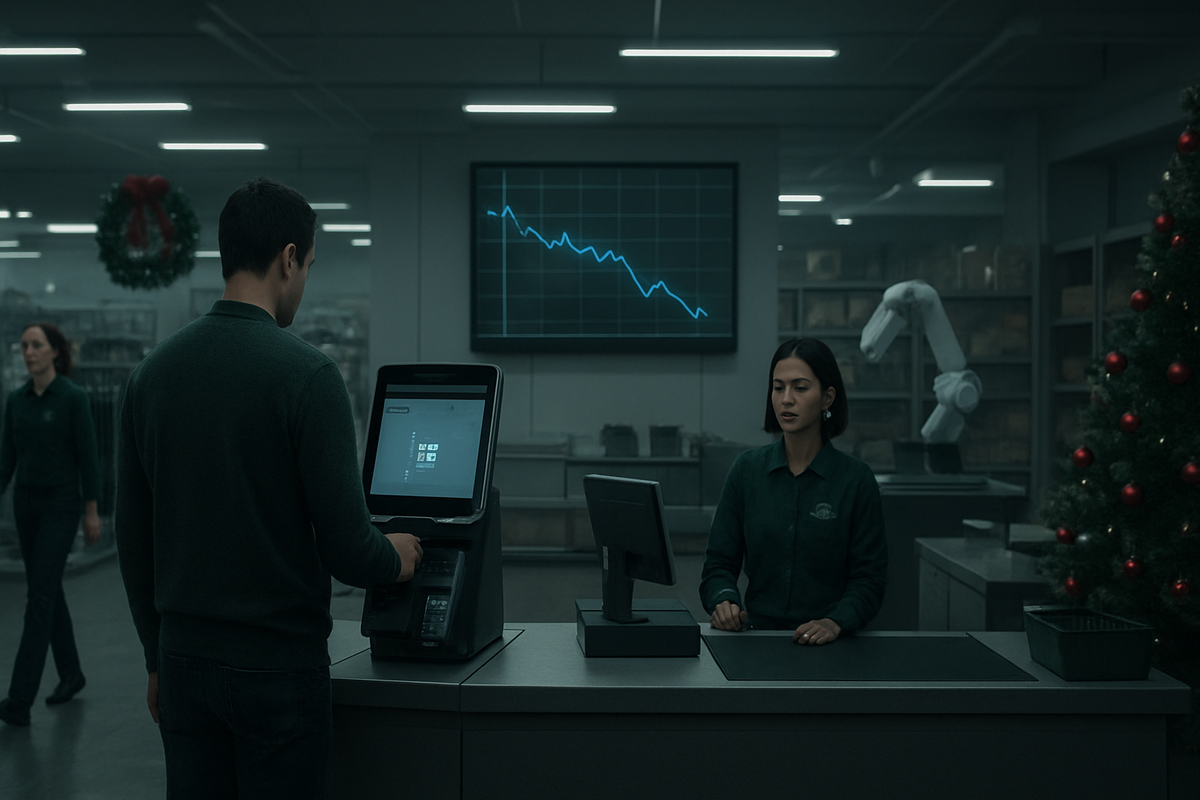
The U.S. retail sector is facing a significantly subdued holiday hiring season in October, with job postings plummeting to levels not seen since the 2008 financial crisis. This sharp decline signals a cautious outlook from retailers, who are grappling with economic uncertainty, persistent inflationary pressures, and evolving consumer behaviors. The immediate implication is a shift towards a "doing more with less" strategy, with companies prioritizing existing staff and automation over a traditional influx of temporary seasonal workers. This trend not only impacts job seekers but also raises broader economic concerns about the cooling labor market and consumer confidence.
This slump in seasonal hiring is a stark indicator of a retail landscape in flux, where efficiency and technological integration are becoming paramount. While holiday sales are still projected to reach record highs, the method of achieving those sales is undergoing a fundamental transformation, with profound consequences for the industry's workforce and operational strategies.
Retailers Adopt "Lean and Mean" Approach Amidst Economic Headwinds
The reported slump in US retail holiday job postings for October is more than just a seasonal dip; it's a clear signal of a strategic pivot within the industry. Projections for overall seasonal hiring for the last quarter of the year could fall to levels not seen since the 2009 recession, marking the lowest October hiring total for retailers since 2018. Instead of bringing in large waves of temporary staff, many retailers are opting to offer additional hours to their permanent employees, leveraging "on-demand" workers, and investing heavily in automation.
This cautious stance is driven by a confluence of factors. Economic uncertainty, lingering inflationary pressures, and the impact of tariffs are compelling businesses to delay hiring plans to offset increased costs. The government shutdown, which began on October 1st, also created further uncertainty, hindering retailers' ability to make informed decisions due to delays in economic data releases. Despite a modest 2.7% year-over-year increase in seasonal job postings, job seeker interest surged by 27% year-over-year by the end of September, indicating a highly competitive holiday job market for applicants.
Initial reactions from industry experts underscore the gravity of the situation. Andrew Challenger, Senior Vice President at Challenger, Gray & Christmas, Inc., highlighted the "confluence of factors" retailers face, including "tariffs loom, inflationary pressures linger, and many companies continue to rely on automation and permanent staff instead of large waves of seasonal hires." He suggests retailers are "not betting on a big seasonal surge" and are focused on "doing more with less." Sky Canaves, a retail analyst at eMarketer, warned that leaner staffing might lead to a "self-fulfilling cycle" of poor customer experiences and reduced consumer returns.
A Tale of Two Retailers: Winners and Losers Emerge
The current hiring slump is creating a clear divide among public companies, with those embracing technology and optimizing existing workforces poised to gain, while others heavily reliant on traditional seasonal hiring may struggle.
Potential Winners:
Companies that have proactively invested in automation and artificial intelligence (AI) are well-positioned. Amazon (NASDAQ: AMZN), a leader in automation, continues to invest billions in expanding its robotics networks in fulfillment centers. While announcing 250,000 seasonal hires (consistent with previous years), these roles often complement their automated systems, focusing on crucial delivery and fulfillment sectors. This strategy reduces per-unit handling costs by over 20%. Similarly, Walmart (NYSE: WMT) is accelerating the transformation of its distribution hubs into semi-autonomous facilities, with automation covering over half of its logistics volume, enhancing speed and reducing reliance on human labor for core operations. Both Amazon and Walmart also prioritize offering additional hours to their existing staff.
Retailers emphasizing existing staff and flexible labor models are also likely to succeed. Target (NYSE: TGT) has explicitly stated its focus on offering additional hours to existing workers and utilizing its network of 43,000 "on-demand" workers. Dick's Sporting Goods (NYSE: DKS) has seen a steady decline in employee turnover, allowing them to manage holiday demand more efficiently with a stable, experienced workforce. Luxury retailers like those under LVMH (EPA: LVMH) or Richemont (SWX: CFR) may also be less impacted, as their hiring often focuses on attracting highly motivated permanent employees who value brand affiliation and provide high-touch sales environments, driving large holiday purchases and long-term loyalty.
Potential Losers:
Conversely, companies that historically rely heavily on large waves of temporary seasonal workers without significant automation or a robust existing staff strategy may face operational strain. Certain Department Stores (e.g., Macy's (NYSE: M), Kohl's (NYSE: KSS)) that traditionally hired tens of thousands of seasonal workers could struggle to secure adequate staffing. If demand outstrips their optimized workforce, they risk understaffing, leading to long lines, stockouts, and overwhelmed employees, ultimately degrading the customer experience and potentially driving customers to competitors. Kroger (NYSE: KR), a major supermarket retailer, is trimming its holiday hiring by nearly 30% compared to last year. While a cost-saving measure, this reduction could strain operations during peak grocery shopping periods if not adequately offset by increased efficiency elsewhere. Any price-sensitive, discount market segment retailers that cannot manage increased foot traffic or online orders due to insufficient staffing could also suffer direct losses in sales and customer satisfaction.
A Structural Shift: Beyond Seasonal Fluctuations
The slump in US retail holiday job postings is more than just an economic blip; it signifies a profound structural transformation within the retail landscape. This event fits into broader industry trends that have been accelerating for years, particularly e-commerce growth, automation, and evolving consumer behavior.
The relentless rise of e-commerce is perhaps the most significant factor. Online shopping has fundamentally reshaped the holiday workforce, reducing the demand for in-store staff while simultaneously increasing the need for roles in online fulfillment, logistics, and distribution centers. Companies like Amazon (NASDAQ: AMZN) and UPS (NYSE: UPS) are leading holiday hiring in these e-commerce-centric areas, with e-commerce expected to create 450,000 jobs by 2026. Automation and technology integration are equally pivotal. Retailers are heavily investing in AI for supply chain management, warehousing, and customer service, allowing them to handle peak demand with fewer human workers. This technological adoption means fewer human workers are needed to handle increasing volumes, especially for repetitive tasks.
The ripple effects extend across the ecosystem. Competitors are pressured to similarly transform their business models and labor strategies or risk falling behind. Logistics and warehousing partners, while seeing sustained demand, must contend with the need for efficiency and automation. Suppliers face shifts in demand patterns, emphasizing efficient, high-volume supply chains for e-commerce. Technology providers, especially those offering e-commerce platforms, automation solutions, and AI recruitment tools, are likely to see increased demand.
Regulatory and policy implications are also emerging. As roles shift and automation becomes prevalent, labor laws need to be examined to ensure adequate worker protections. The increasing use of AI in recruitment raises questions about potential biases, with some states already implementing regulations for bias audits. Historical precedents, such as the Great Recession (2008-2009) and the acceleration of e-commerce during the COVID-19 pandemic, highlight that this is not a new phenomenon but an intensified continuation of a decade-long retail crisis characterized by store closures and job losses.
The Future of Retail: Leaner, Smarter, and More Automated
Looking ahead, the retail sector is poised for a significant restructuring. In the short term, retailers will maintain a cautious hiring approach, continuing to prioritize efficiency and relying on existing staff to navigate economic uncertainty. Delayed hiring decisions and a focus on employee retention will be key strategies.
Long-term possibilities point towards a profoundly reshaped labor market. Automation and AI are expected to dramatically transform retail jobs, with routine tasks becoming increasingly automated. This will lead to a significant evolution of roles, requiring a shift in skills towards digital literacy, problem-solving, data analysis, and enhanced customer service for online engagements. E-commerce dominance will continue to drive demand for new roles in fulfillment, logistics, and digital customer service, even as traditional brick-and-mortar positions decline.
Strategic pivots are essential for retailers. Aggressive technology adoption, including investments in AI for operations and self-checkout systems, will be critical. Workforce reskilling and upskilling programs are necessary to equip employees with new digital and technical skills. Retailers must also enhance their employee value proposition through competitive compensation, flexible work schedules, and a positive work culture to attract and retain talent. Seamless omnichannel integration, blending online and physical store experiences, will be paramount to meet evolving consumer expectations.
Market opportunities will emerge in e-commerce and logistics, data and AI-driven roles, and personalized customer experiences. However, challenges include ongoing economic headwinds, talent scarcity, rising cost pressures, and the need to manage the social impact of automation. Potential scenarios range from a "Lean and Tech-Enabled" retail environment with a highly skilled workforce to a "Stagnation and Contraction" scenario if retailers fail to adapt, leading to widespread job losses.
A New Era for Retail: Adaptation is Key
The slump in US retail holiday job postings is a powerful signal of an industry in the midst of a profound and lasting transformation. The key takeaways are clear: retailers are prioritizing efficiency, leveraging technology, and optimizing their existing workforces in response to economic uncertainties and the relentless growth of e-commerce. This is not merely a transient economic dip but a structural shift that will redefine how the retail sector operates and staffs itself for years to come.
Moving forward, the market will be characterized by a leaner, more technologically advanced retail workforce. Traditional roles will continue to be redefined, and new skills, particularly in digital logistics, data interpretation, and tech-supported customer interactions, will be highly valued. The lasting impact will be a retail industry that is more resilient, more agile, and more integrated with technology than ever before.
Investors should closely monitor several key indicators in the coming months. Pay attention to consumer spending patterns, distinguishing between online and in-store performance, and the impact of inflation and tariffs. Observe retailers' investments in e-commerce platforms, fulfillment centers, and automation technologies. Track broader labor market trends, including employment figures and wage growth, as these will influence both consumer sentiment and retailers' ability to attract talent. Finally, scrutinize individual company strategies and holiday season performance, noting those successfully "doing more with less" or shifting towards year-round, specialized hiring. The ability to adapt to this new retail paradigm will be the ultimate differentiator for success.
This content is intended for informational purposes only and is not financial advice







